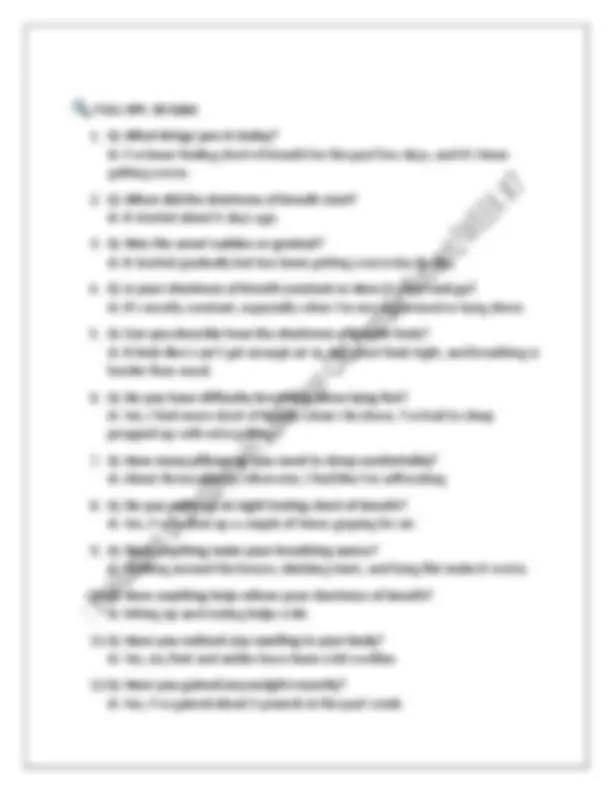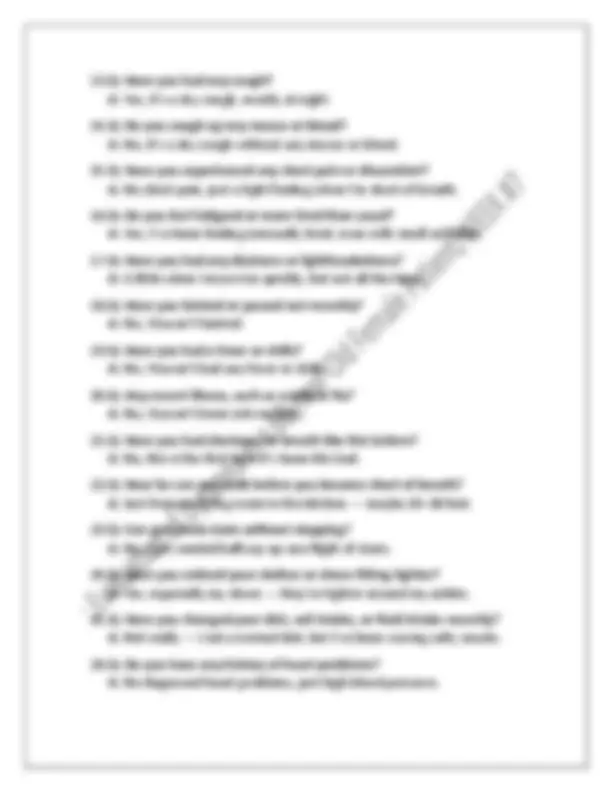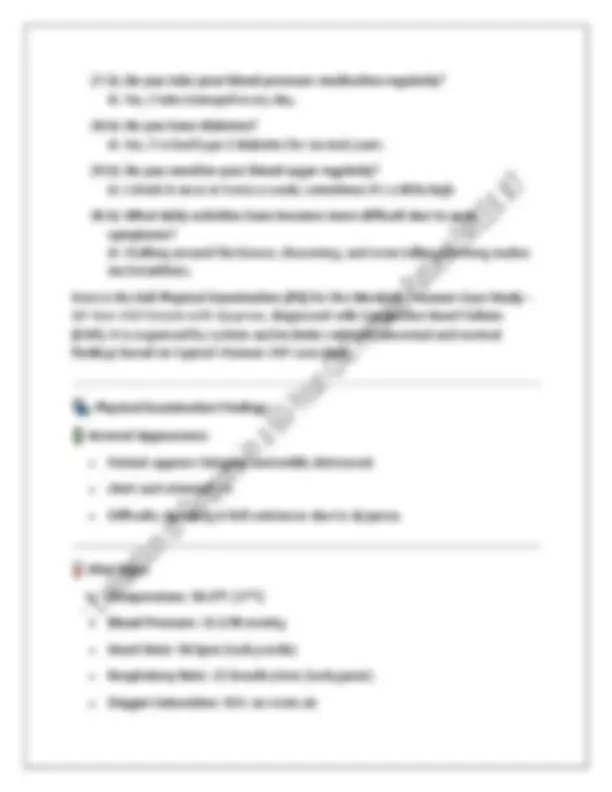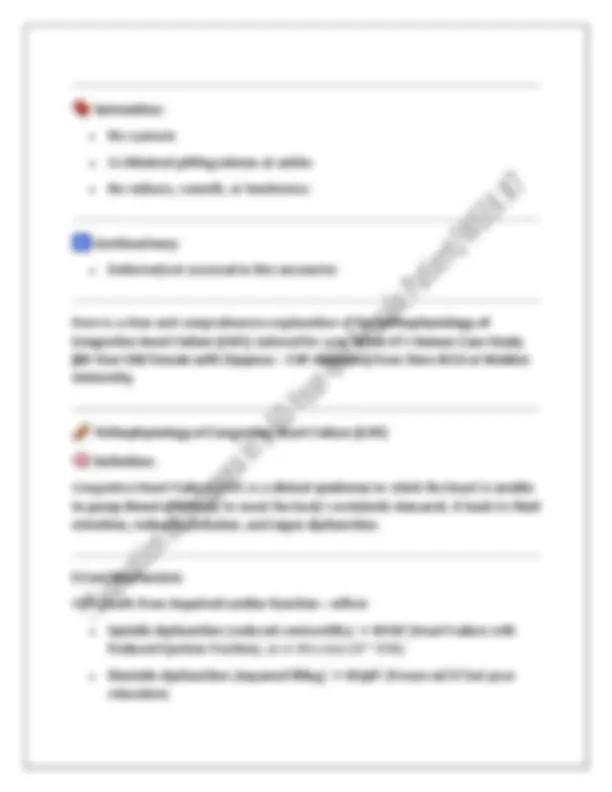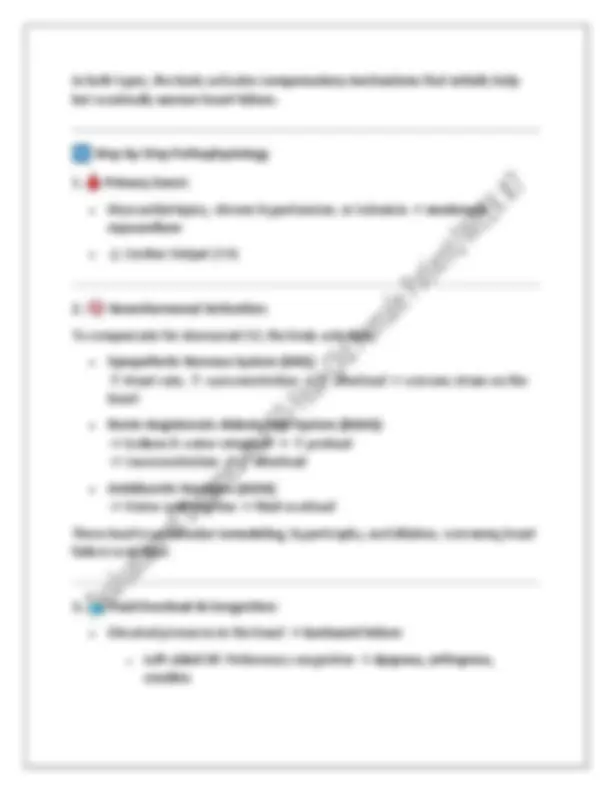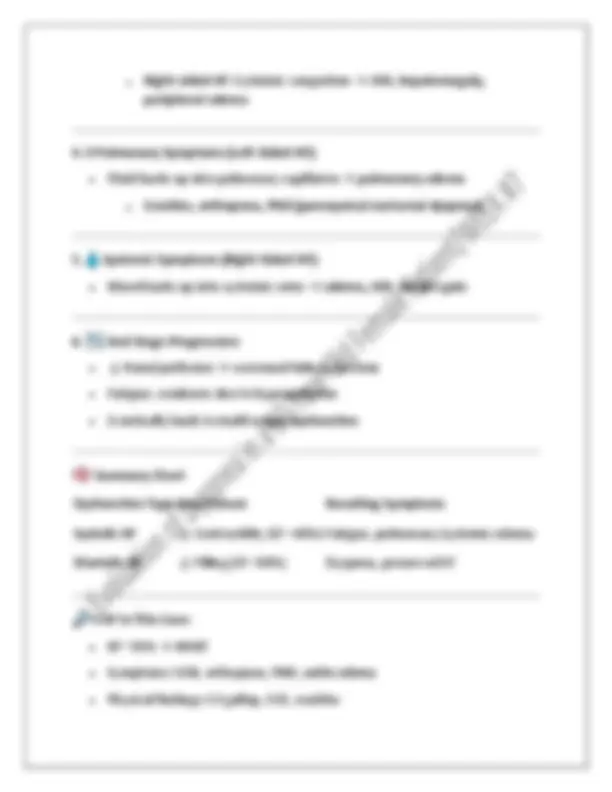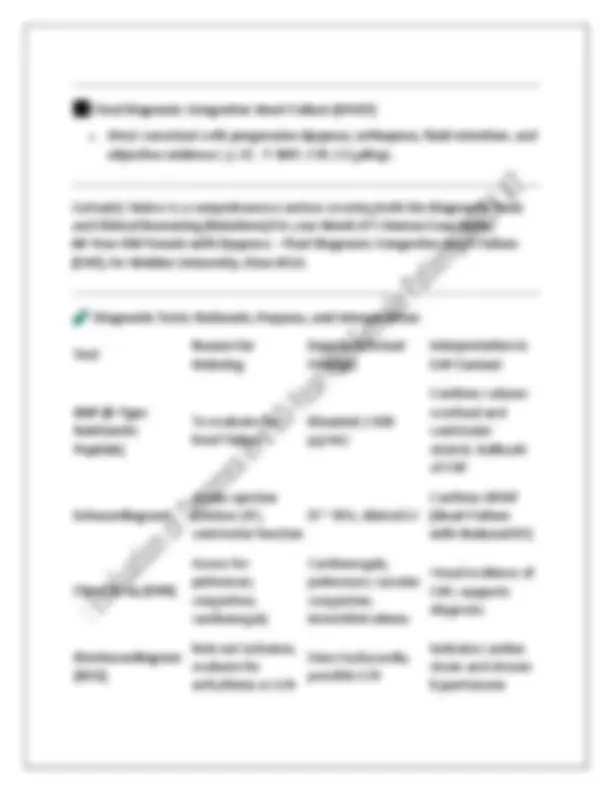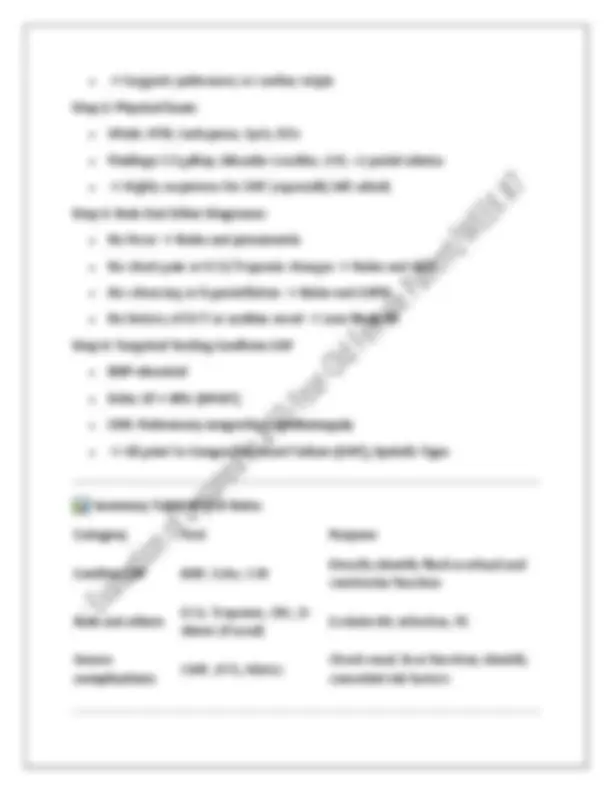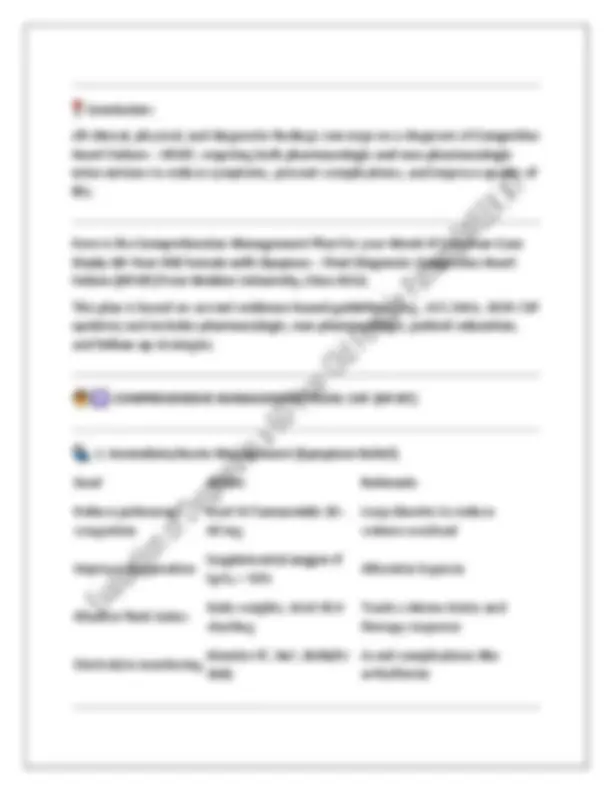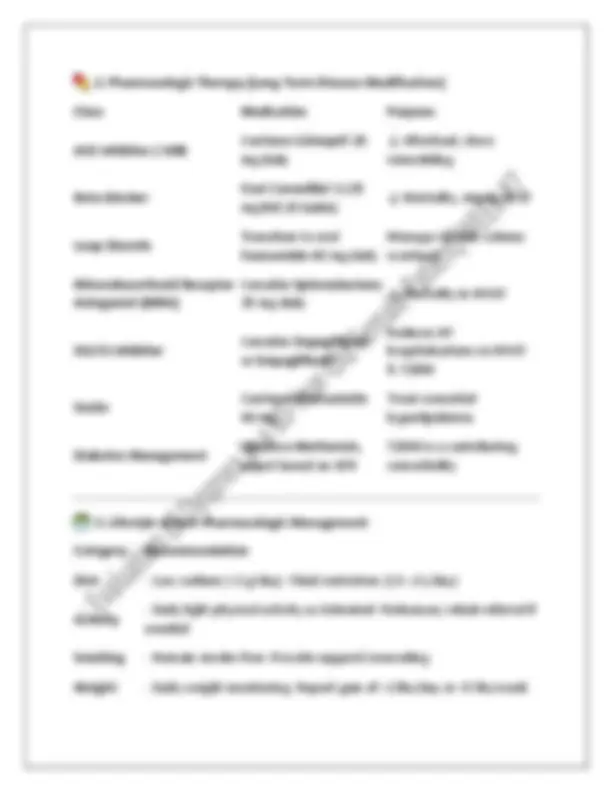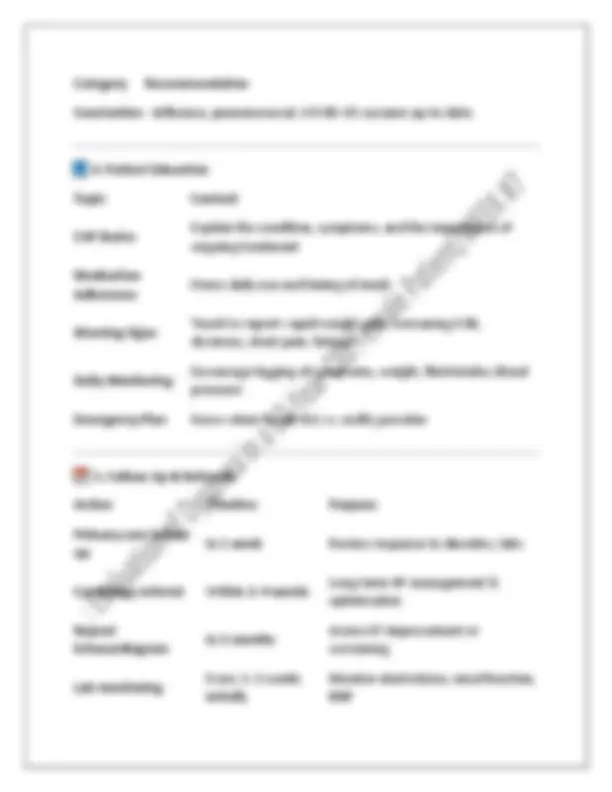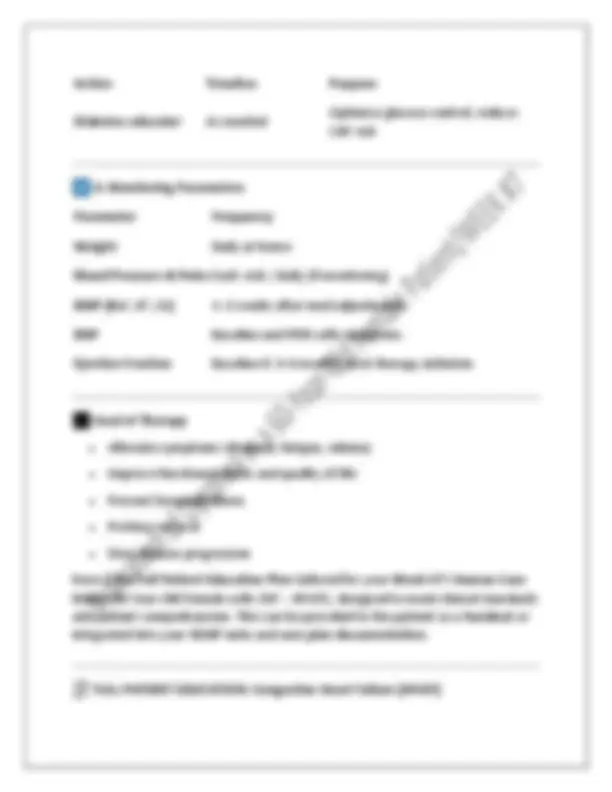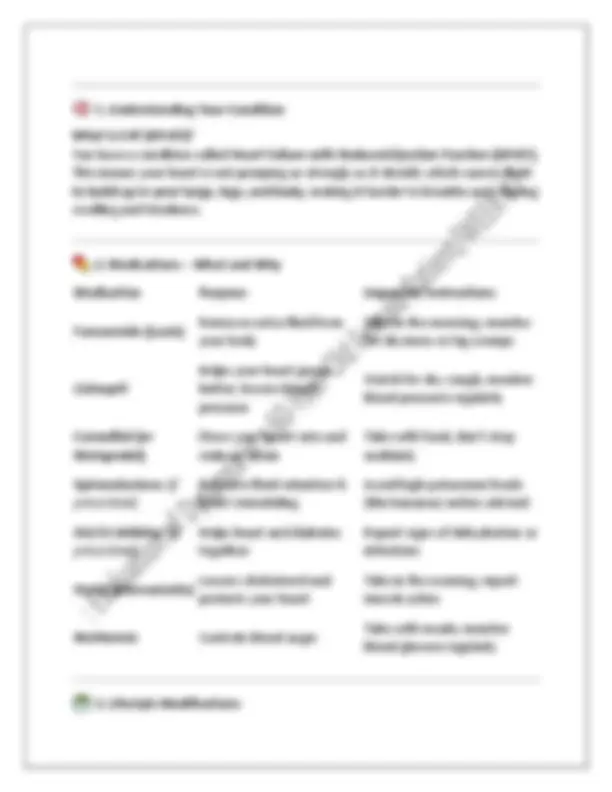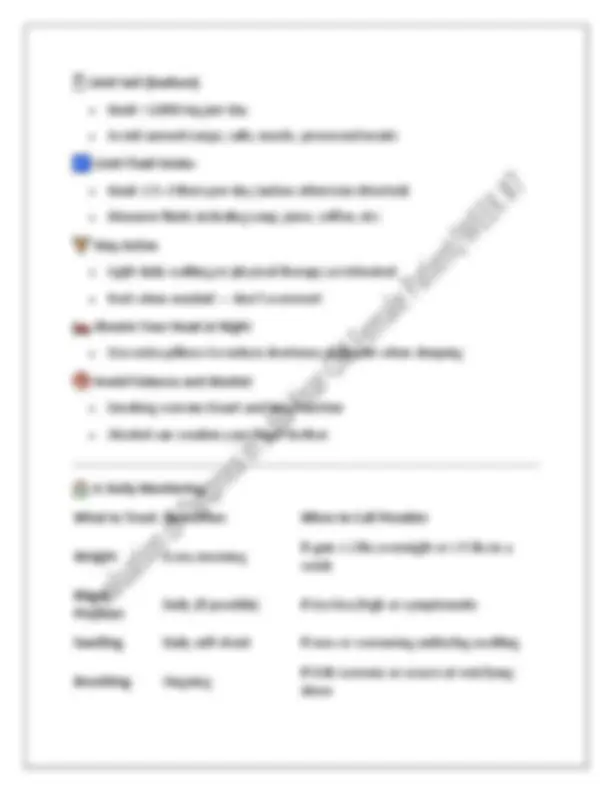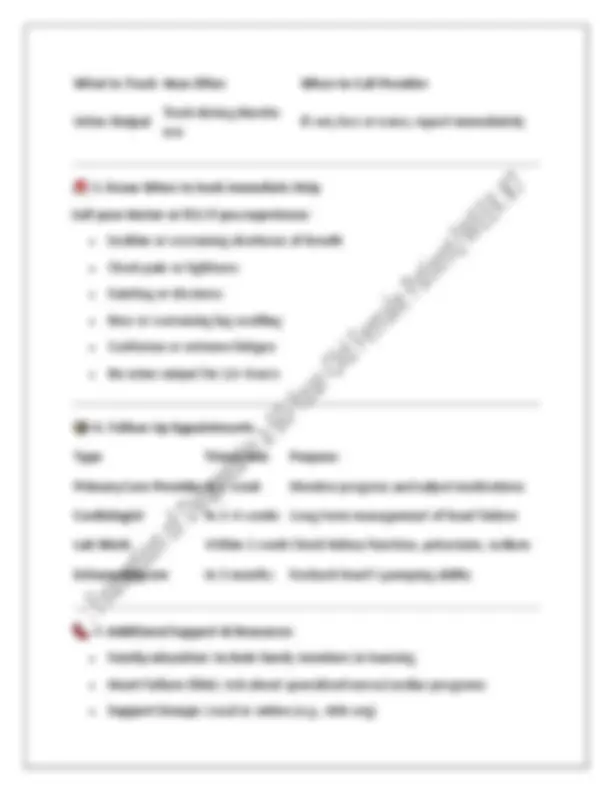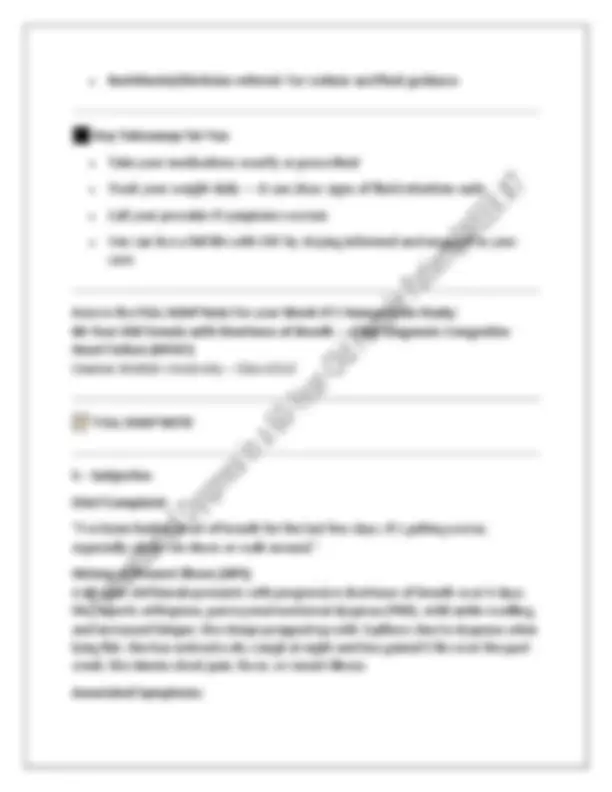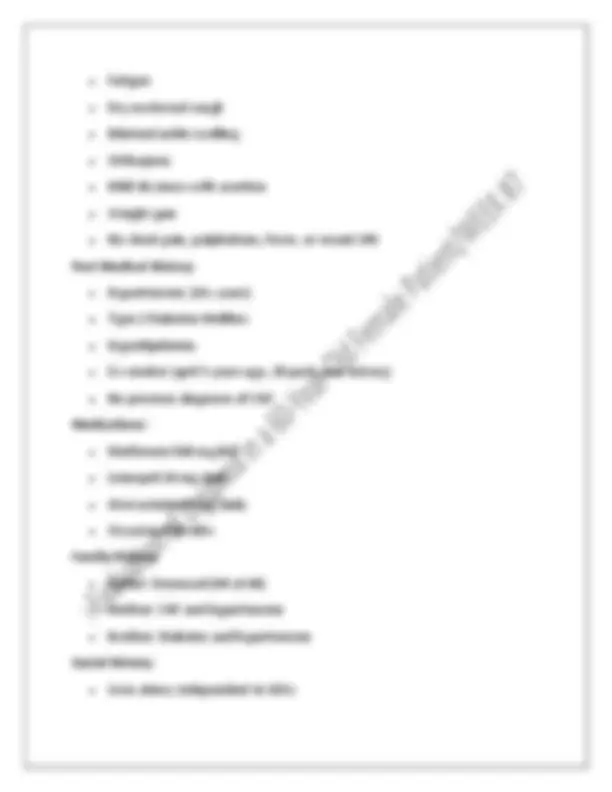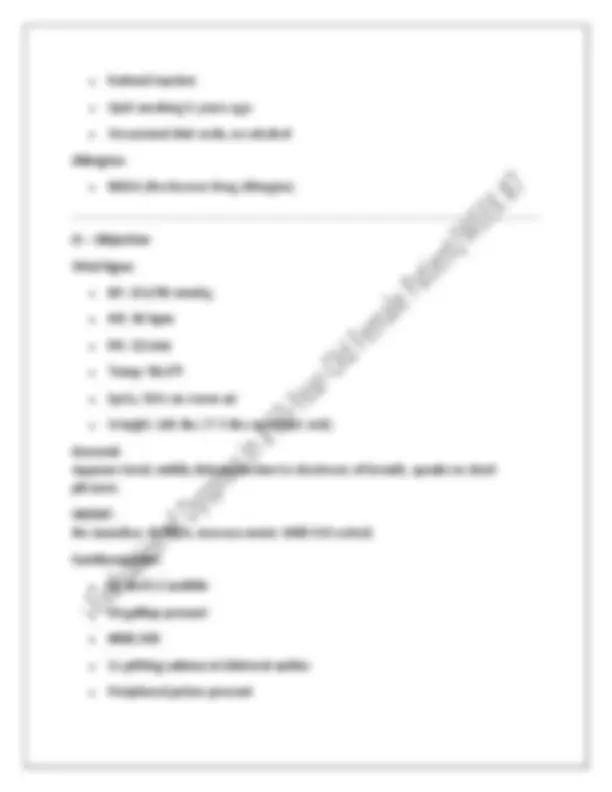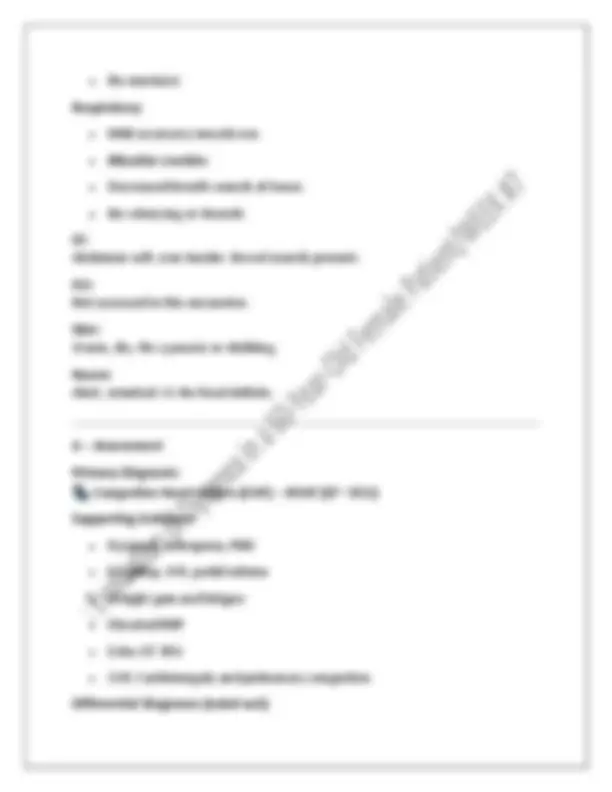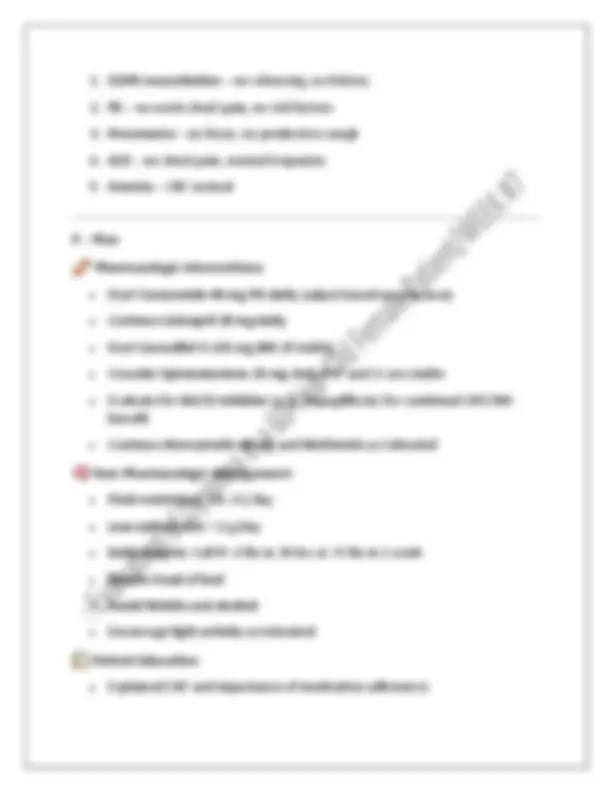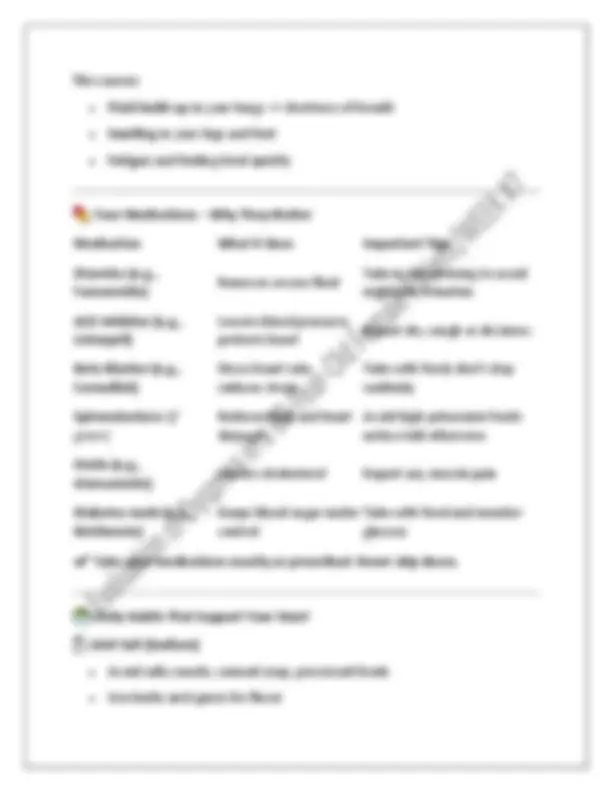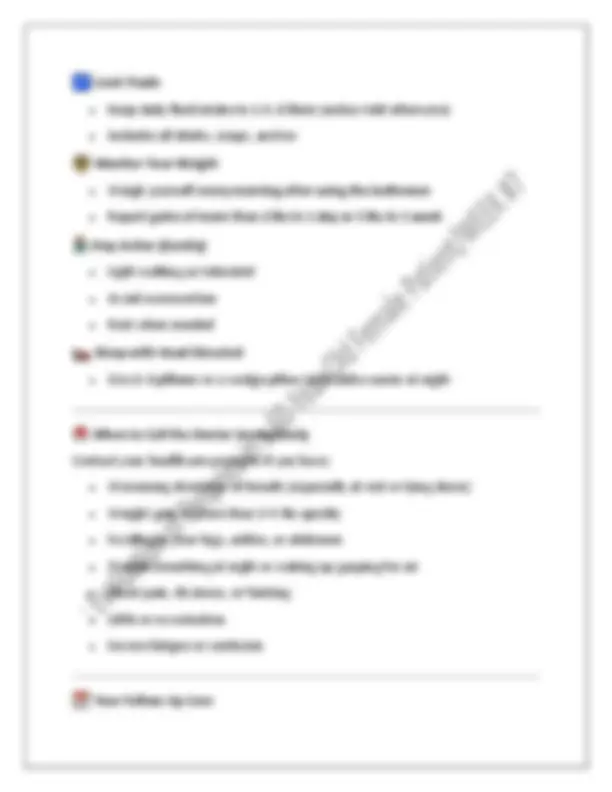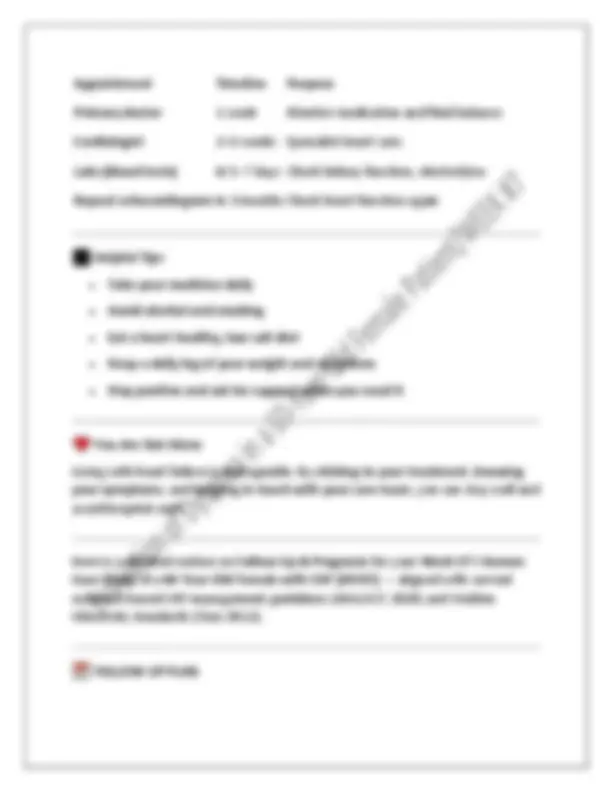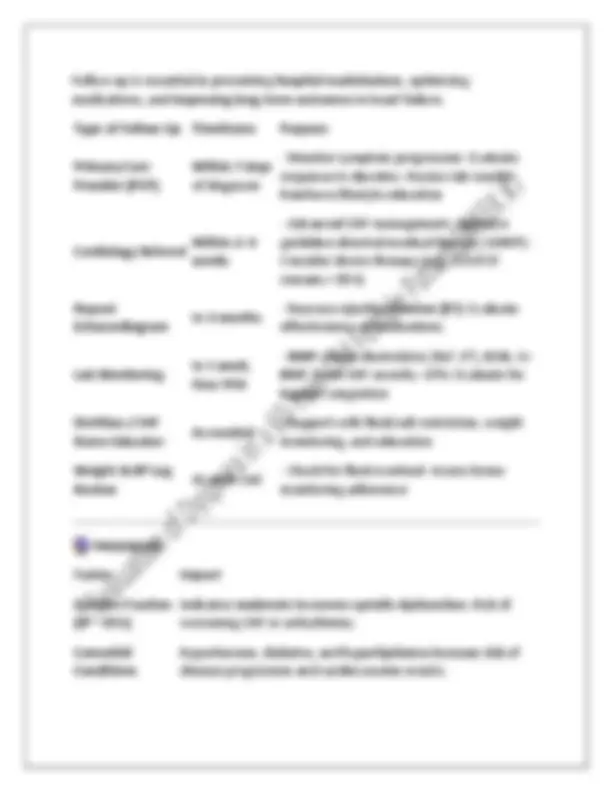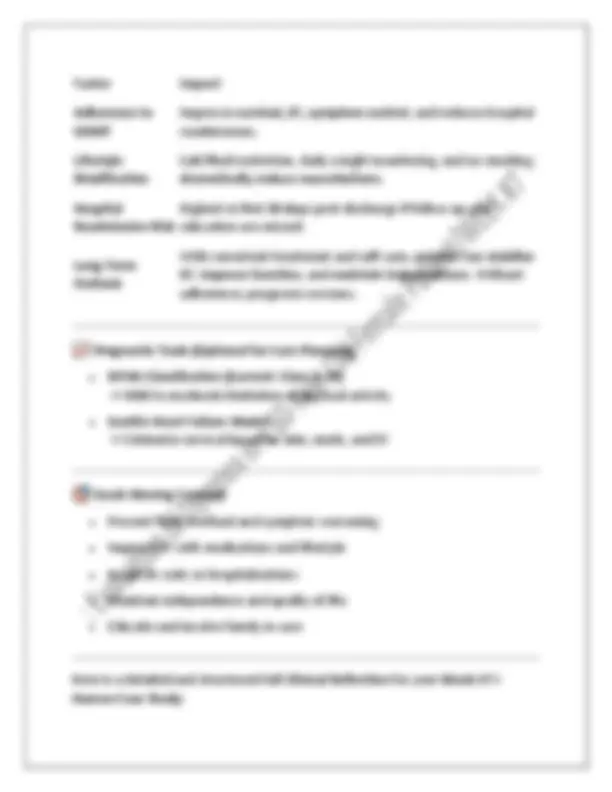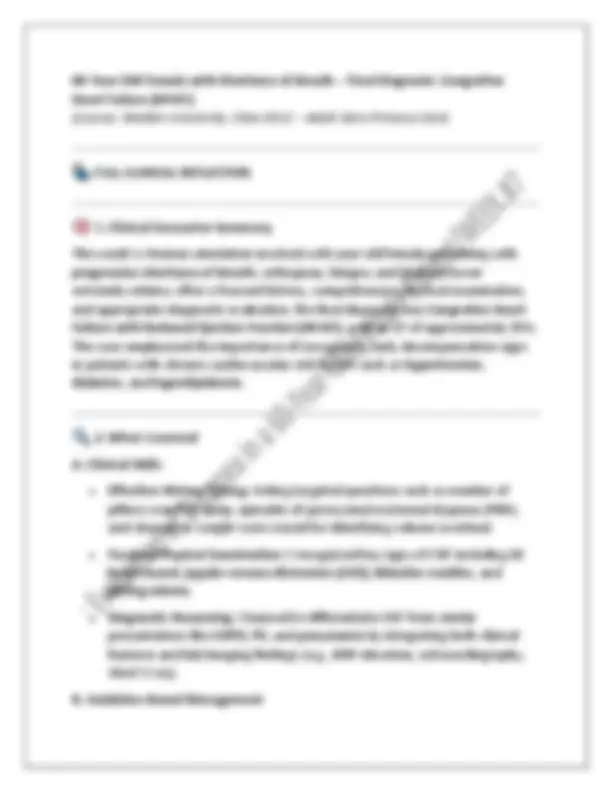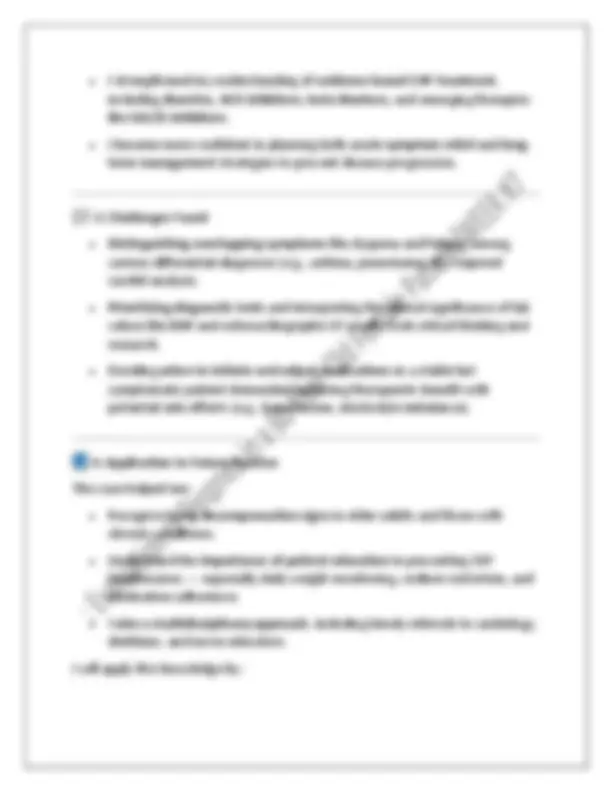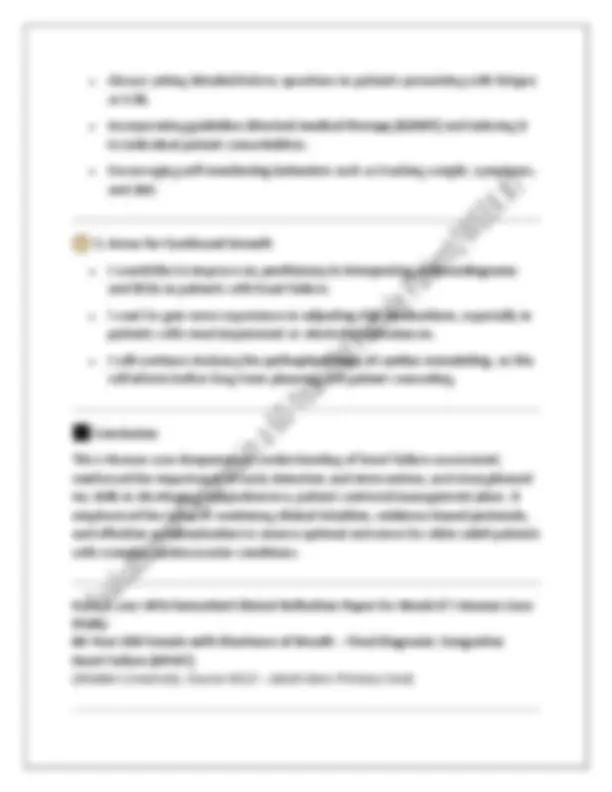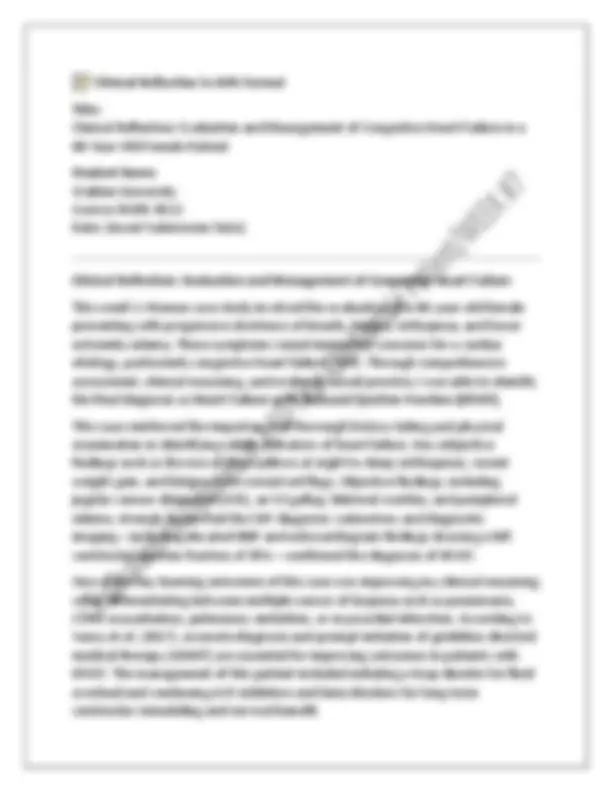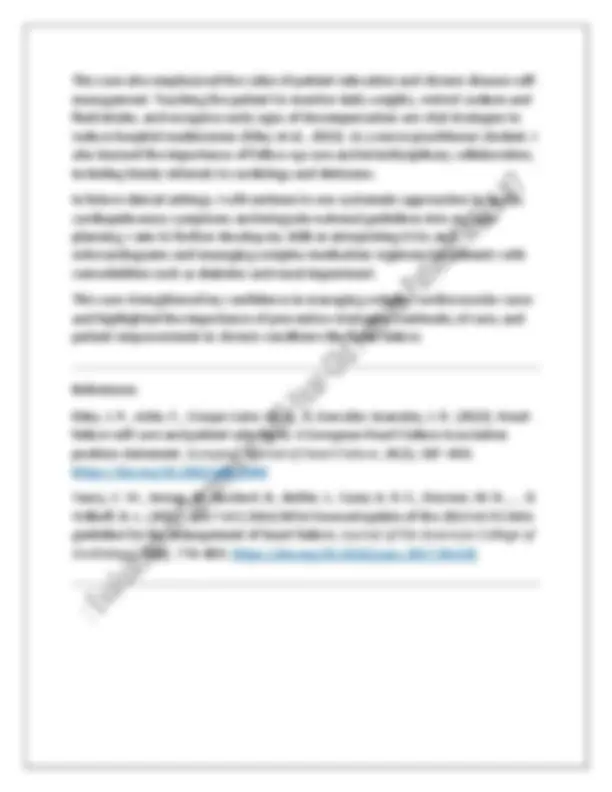Download Week #7 i-Human Case Study: Evaluation of Dyspnea in a 60-Year-Old Female Patient/WEEK #7 and more Exams Integrated Case Studies in PDF only on Docsity!
Week #7 i-Human Case Study: Evaluation of Dyspnea
in a 60-Year-Old Female Patient/WEEK #7 CASE STUDY
ACTUAL SCREENSHOT PRESENT 60 YEAR OLD FEMALE
PATIENT REASON ; SHORTNESS OF BREATH (6512 ).
WALDEN UNIVERSITY Comprehensive Case Analysis:
CHF Diagn
- Q: Have you had any cough? A: Yes, it’s a dry cough, mostly at night.
- Q: Do you cough up any mucus or blood? A: No, it’s a dry cough without any mucus or blood.
- Q: Have you experienced any chest pain or discomfort? A: No chest pain, just a tight feeling when I’m short of breath.
- Q: Do you feel fatigued or more tired than usual? A: Yes, I’ve been feeling unusually tired, even with small activities.
- Q: Have you had any dizziness or lightheadedness? A: A little when I move too quickly, but not all the time.
- Q: Have you fainted or passed out recently? A: No, I haven’t fainted.
- Q: Have you had a fever or chills? A: No, I haven’t had any fever or chills.
- Q: Any recent illness, such as a cold or flu? A: No, I haven’t been sick recently.
- Q: Have you had shortness of breath like this before? A: No, this is the first time it’s been this bad.
- Q: How far can you walk before you become short of breath? A: Just from my living room to the kitchen — maybe 20–30 feet.
- Q: Can you climb stairs without stopping? A: No, I get winded halfway up one flight of stairs.
- Q: Have you noticed your clothes or shoes fitting tighter? A: Yes, especially my shoes — they’re tighter around my ankles.
- Q: Have you changed your diet, salt intake, or fluid intake recently? A: Not really — I eat a normal diet, but I’ve been craving salty snacks.
- Q: Do you have any history of heart problems? A: No diagnosed heart problems, just high blood pressure.
- Q: Do you take your blood pressure medication regularly? A: Yes, I take Lisinopril every day.
- Q: Do you have diabetes? A: Yes, I’ve had type 2 diabetes for several years.
- Q: Do you monitor your blood sugar regularly? A: I check it once or twice a week; sometimes it’s a little high.
- Q: What daily activities have become more difficult due to your symptoms? A: Walking around the house, showering, and even talking too long makes me breathless. Here is the full Physical Examination (PE) for the Week #7 i-Human Case Study – 60 - Year-Old Female with Dyspnea , diagnosed with Congestive Heart Failure (CHF). It is organized by system and includes relevant abnormal and normal findings based on typical i-Human CHF case data. Physical Examination Findings General Appearance:
- Patient appears fatigued and mildly distressed.
- Alert and oriented ×3.
- Difficulty speaking in full sentences due to dyspnea. Vital Signs:
- Temperature: 98.6°F (37°C)
- Blood Pressure: 152/90 mmHg
- Heart Rate: 96 bpm (tachycardic)
- Respiratory Rate: 22 breaths/min (tachypneic)
- Oxygen Saturation: 91% on room air
- No wheezing or rhonchi
- Decreased breath sounds at bilateral bases Musculoskeletal:
- Moves slowly due to shortness of breath
- No joint swelling or deformity Neurological:
- Alert, oriented to person, place, time
- No focal neurological deficits Gastrointestinal (GI):
- Abdomen soft, non-tender, no hepatosplenomegaly
- Bowel sounds normal in all quadrants Integumentary:
- Skin warm, dry
- No rashes or cyanosis
- No clubbing of fingers Mental Status:
- Cooperative
- Mildly anxious due to dyspnea
- Cognition intact
Extremities:
- No cyanosis
- 1+ bilateral pitting edema at ankles
- No redness, warmth, or tenderness Genitourinary:
- Deferred/not assessed in this encounter Here is a clear and comprehensive explanation of the pathophysiology of Congestive Heart Failure (CHF) , tailored for your Week #7 i-Human Case Study (60-Year-Old Female with Dyspnea – CHF diagnosis) from Class 6512 at Walden University. Pathophysiology of Congestive Heart Failure (CHF) Definition: Congestive Heart Failure (CHF) is a clinical syndrome in which the heart is unable to pump blood effectively to meet the body’s metabolic demands. It leads to fluid retention, reduced perfusion , and organ dysfunction. 🫀 Core Mechanism: CHF results from impaired cardiac function —either:
- Systolic dysfunction (reduced contractility) → HFrEF (Heart Failure with Reduced Ejection Fraction), as in this case (EF ~35%)
- Diastolic dysfunction (impaired filling) → HFpEF (Preserved EF but poor relaxation)
o Right-sided HF: Systemic congestion → JVD, hepatomegaly, peripheral edema
4. 🫀 Pulmonary Symptoms (Left-Sided HF): - Fluid backs up into pulmonary capillaries → pulmonary edema o **Crackles, orthopnea, PND (paroxysmal nocturnal dyspnea)
- Systemic Symptoms (Right-Sided HF):**
- Blood backs up into systemic veins → **edema, JVD, weight gain
- End-Stage Progression:**
- ↓ Renal perfusion → worsened kidney function
- Fatigue, weakness due to hypoperfusion
- Eventually leads to multi-organ dysfunction Summary Chart Dysfunction Type Key Feature Resulting Symptoms Systolic HF ↓ Contractility (EF <40%) Fatigue, pulmonary/systemic edema Diastolic HF ↓ Filling (EF >50%) Dyspnea, preserved EF CHF in This Case:
- EF ~35% → HFrEF
- Symptoms: SOB, orthopnea, PND, ankle edema
- Physical findings: S3 gallop, JVD, crackles
- Diagnostics: ↑ BNP, enlarged heart on CXR Clinical Implications:
- Identify & treat the underlying cause (e.g., HTN, ischemia)
- Manage fluid overload with diuretics
- Use RAAS and SNS blockers (ACE inhibitors, beta-blockers)
- Monitor renal function and electrolytes closely Here is a detailed Differential Diagnosis Table for your Week #7 i-Human Case Study: 60-Year-Old Female with Dyspnea , designed to distinguish Congestive Heart Failure (CHF) from other likely conditions presenting with shortness of breath. **Differential Diagnosis Table for Dyspnea in a 60-Year-Old Female Diagnosis Key Features Findings Supporting Diagnosis Findings Against Diagnosis
- Congestive Heart Failure (CHF)** Orthopnea, paroxysmal nocturnal dyspnea, peripheral edema, fatigue, weight gain
- Bilateral crackles- S3 gallop- JVD- Pitting edema- Elevated BNP- ↓ Ejection fraction (EF ~35%)- Cardiomegaly on CXR
- No fever- No chest pain 2. Chronic Obstructive Pulmonary Dyspnea, chronic cough, wheezing,
- Smoking history- Wheezing (if present)
- No wheezing or prolonged expiration- Normal CO2 on
✅ Final Diagnosis: Congestive Heart Failure (HFrEF)
- Most consistent with progressive dyspnea , orthopnea , fluid retention , and objective evidence (↓ EF, ↑ BNP, CXR, S3 gallop). Certainly! Below is a comprehensive section covering both the Diagnostic Tests and Clinical Reasoning (Rotations) for your Week #7 i-Human Case Study : 60 - Year-Old Female with Dyspnea – Final Diagnosis: Congestive Heart Failure (CHF) , for Walden University, Class 6512. Diagnostic Tests: Rationale, Purpose, and Interpretation Test Reason for Ordering Expected/Actual Findings Interpretation in CHF Context BNP (B-Type Natriuretic Peptide) To evaluate for heart failure Elevated (> pg/mL) Confirms volume overload and ventricular stretch, hallmark of CHF Echocardiogram Assess ejection fraction (EF), ventricular function EF ~35%, dilated LV Confirms HFrEF (Heart Failure with Reduced EF) Chest X-ray (CXR) Assess for pulmonary congestion, cardiomegaly Cardiomegaly, pulmonary vascular congestion, interstitial edema Visual evidence of CHF; supports diagnosis Electrocardiogram (ECG) Rule out ischemia, evaluate for arrhythmia or LVH Sinus tachycardia, possible LVH Indicates cardiac strain and chronic hypertension
Test Reason for Ordering Expected/Actual Findings Interpretation in CHF Context Complete Blood Count (CBC) Rule out infection/anemia WNL or mild anemia Normal WBC rules out pneumonia; anemia can exacerbate CHF Basic Metabolic Panel (BMP/CMP) Assess renal function, electrolytes (esp. K⁺, Na⁺) Mild hyponatremia, possible ↓ GFR Common in CHF due to fluid retention & RAAS activation HbA1c Monitor diabetes control
Indicates poor glucose control, contributing risk factor TSH (optional) Rule out thyroid- related cardiac symptoms Normal Used if symptoms suggest thyrotoxicosis (not in this case) Troponins Rule out myocardial infarction Negative No evidence of acute coronary event Liver Function Tests (LFTs) Check for hepatic congestion May show mild elevations in CHF Passive hepatic congestion in right-sided HF Clinical Reasoning & Rotations (Differential to Final Diagnosis) Step 1: Initial Presentation
- Chief Complaint: Shortness of breath × 4 days, worsening
- Associated Symptoms: Orthopnea, fatigue, ankle edema, dry cough
Clinical Insight: Early diagnostic testing, especially BNP and echocardiography , plays a vital role in differentiating CHF from respiratory causes of dyspnea. Systematic elimination of differentials through appropriate rotations and labs ensures timely diagnosis and management. Here is a structured and concise explanation of the Final Diagnosis for your Week #7 i-Human Case Study (60-Year-Old Female with Dyspnea) from Walden University, Class 6512 : ✅ Final Diagnosis: Congestive Heart Failure (CHF) – HFrEF (Heart Failure with Reduced Ejection Fraction) Definition: HFrEF is a form of heart failure where the left ventricle cannot pump blood effectively , resulting in reduced ejection fraction (<40%) , fluid accumulation, and poor organ perfusion. Key Diagnostic Features in This Case: Category Findings Symptoms
- Shortness of breath- Orthopnea- Paroxysmal nocturnal dyspnea (PND)- Fatigue- Ankle swelling Physical Exam
- S3 gallop- Jugular venous distension (JVD)- Bilateral crackles- 1+ pitting edema Diagnostic Tests
- BNP: Elevated (>500 pg/mL)- Echocardiogram: EF ~35% (confirming HFrEF)- Chest X-ray: Cardiomegaly, pulmonary congestion- ECG: Sinus tachycardia, LVH
Category Findings Risk Factors
- Long-standing hypertension- Type 2 diabetes mellitus- Hyperlipidemia- Smoking history Pathophysiology Summary: HFrEF is caused by impaired contractility of the heart, leading to:
- Decreased cardiac output
- Neurohormonal activation (RAAS, SNS, ADH)
- Sodium and water retention
- Pulmonary and systemic congestion Treatment Goals:
- Relieve symptoms (e.g., dyspnea, edema)
- Reduce fluid overload (e.g., diuretics like furosemide)
- Improve cardiac function (e.g., ACE inhibitors, beta-blockers)
- Prevent disease progression and hospitalizations
- Manage comorbidities (HTN, DM, dyslipidemia) Evidence-Based Management (Initiated or Recommended):
- Loop diuretic : Furosemide 20–40 mg IV → PO
- ACE inhibitor : Continue or optimize lisinopril
- Beta-blocker : Add if hemodynamically stable
- Lifestyle modifications : Low-sodium diet, daily weights, fluid restriction
- Referral : Cardiology for further CHF management
2. Pharmacologic Therapy (Long-Term Disease Modification) Class Medication Purpose ACE Inhibitor / ARB Continue Lisinopril 20 mg daily ↓ Afterload, slows remodeling Beta-blocker Start Carvedilol 3. mg BID (if stable) ↓ Mortality, improves EF Loop Diuretic Transition to oral Furosemide 40 mg daily Manage chronic volume overload Mineralocorticoid Receptor Antagonist (MRA) Consider Spironolactone 25 mg daily ↓ Mortality in HFrEF SGLT2 Inhibitor Consider Dapagliflozin or Empagliflozin Reduces HF hospitalizations in HFrEF & T2DM Statin Continue Atorvastatin 40 mg Treat comorbid hyperlipidemia Diabetes Management Optimize Metformin , adjust based on GFR T2DM is a contributing comorbidity 3. Lifestyle & Non-Pharmacologic Management Category Recommendation Diet - Low sodium (<2 g/day)- Fluid restriction (1.5–2 L/day) Activity
- Daily light physical activity as tolerated- Pulmonary rehab referral if needed Smoking - Remain smoke-free- Provide support/counseling Weight - Daily weight monitoring- Report gain of >2 lbs/day or >5 lbs/week
Category Recommendation Vaccination - Influenza, pneumococcal, COVID-19 vaccines up-to-date
4. Patient Education Topic Content CHF Basics Explain the condition, symptoms, and the importance of ongoing treatment Medication Adherence Stress daily use and timing of meds Warning Signs Teach to report: rapid weight gain, worsening SOB, dizziness, chest pain, fatigue Daily Monitoring Encourage logging of symptoms, weight, fluid intake, blood pressure Emergency Plan Know when to call 911 vs. notify provider 5. Follow-Up & Referrals Action Timeline Purpose Primary care follow- up In 1 week Review response to diuretics, labs Cardiology referral Within 2 – 4 weeks Long-term HF management & optimization Repeat Echocardiogram In 3 months Assess EF improvement or worsening Lab monitoring Every 1–2 weeks initially Monitor electrolytes, renal function, BNP

